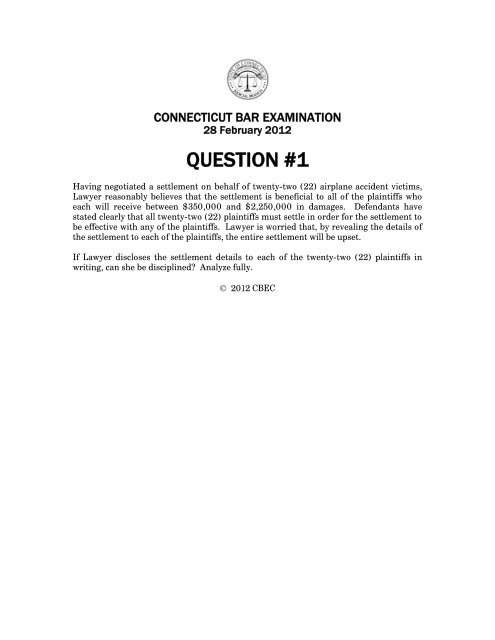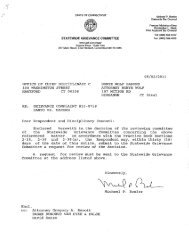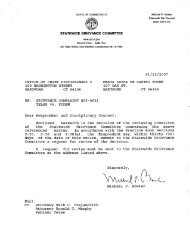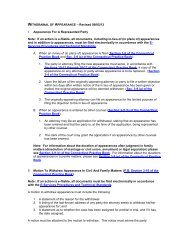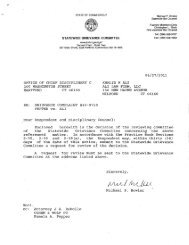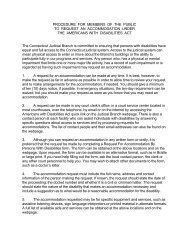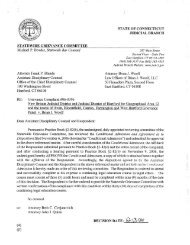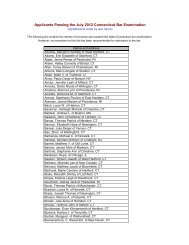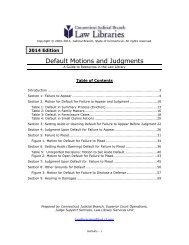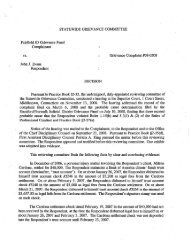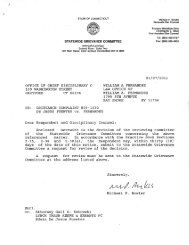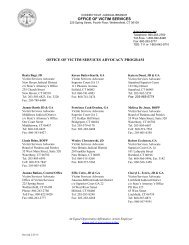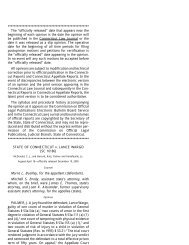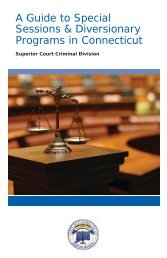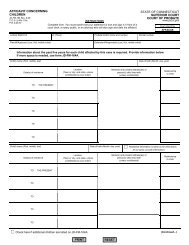Bar Exam Sample Question from February 2012 Exam
Bar Exam Sample Question from February 2012 Exam
Bar Exam Sample Question from February 2012 Exam
- No tags were found...
Create successful ePaper yourself
Turn your PDF publications into a flip-book with our unique Google optimized e-Paper software.
CONNECTICUT BAR EXAMINATION<br />
28 <strong>February</strong> <strong>2012</strong><br />
QUESTION #1<br />
Having negotiated a settlement on behalf of twenty-two (22) airplane accident victims,<br />
Lawyer reasonably believes that the settlement is beneficial to all of the plaintiffs who<br />
each will receive between $350,000 and $2,250,000 in damages. Defendants have<br />
stated clearly that all twenty-two (22) plaintiffs must settle in order for the settlement to<br />
be effective with any of the plaintiffs. Lawyer is worried that, by revealing the details of<br />
the settlement to each of the plaintiffs, the entire settlement will be upset.<br />
If Lawyer discloses the settlement details to each of the twenty-two (22) plaintiffs in<br />
writing, can she be disciplined Analyze fully.<br />
© <strong>2012</strong> CBEC
CONNECTICUT BAR EXAMINATION<br />
28 <strong>February</strong> <strong>2012</strong><br />
QUESTION #2<br />
Emily Entrepreneur (Emily) owned a car dealership in St. Louis that specialized in<br />
selling sports cars to consumers. Emily decided that she wanted to buy 40 new “Series<br />
S” red sports cars. Her plan was to offer them to her customers at a special discount<br />
during the first week of April, when the St. Louis Cardinals were going to play their<br />
season-opening baseball game in St. Louis. Because the Cardinals’ uniforms were red,<br />
she planned a promotion that would tell buyers to “bleed Cardinal red” with a new red<br />
Series S sports car. With that plan in mind, she decided to approach Carco, a<br />
manufacturer in Louisville, Kentucky, to order the cars. On March 5, Emily called Alan<br />
Auto (Alan), President of the Louisville Carco plant, and had a detailed telephone<br />
conversation with him about her need for 40 new red Series S sports cars.<br />
During this call, Emily offered to purchase 40 new red Series S sports cars for $35,000<br />
each, delivery to take place “on or before April 1,” which Emily calculated would give her<br />
almost a week before the date of the Cardinals’ home opener. No other terms were<br />
discussed in this conversation between Emily and Alan beyond quantity, price, type of<br />
car, color of car, and delivery date. After setting out precisely what she needed and what<br />
she was willing to pay, Emily asked Alan whether they had a firm deal, to which Alan<br />
replied enthusiastically, “Yes, we do!”<br />
A couple of days later, both Emily and Alan sent certified letters to the other. Alan’s<br />
letter to Emily, which he signed personally, said the following: “Just following up on our<br />
telephone call. I will send you 40 new blue Series S sports cars for $35,000 each, on or<br />
before April 1. Your exclusive remedy for breach of any warranty will be repair or<br />
replacement of defective parts. This acceptance is expressly conditional on your assent<br />
to any additional or different terms contained within it.” It turned out that the Louisville<br />
Carco plant had an excess of blue Series S sports cars on hand, which Alan was only too<br />
eager to unload. Additionally, Alan was not a baseball fan, and therefore did not fully<br />
appreciate the significance of Emily needing red cars for the special St. Louis Cardinals<br />
promotion.<br />
Emily’s signed letter, which crossed in the mail with Alan’s letter, said the following: “It<br />
was great to speak with you the other day. I just wanted to review our deal: it’s 40 red<br />
Series S sports cars at $35,000 each, delivery on or before April 1. All disputes will be<br />
subject to arbitration. I will, of course, be entitled to all warranties and remedies<br />
available under law.”<br />
Emily and Alan each received the other’s letter on the same day, but were each too busy<br />
to read them. As a result, neither side noticed the various discrepancies between the two<br />
letters, although they did keep the letters for their files.
1. Discuss whether an enforceable contract exists between these two parties after<br />
the letters have been received but prior to shipment of the cars.<br />
2. Assuming arguendo that an enforceable contract does exist after the letters have<br />
been received but prior to shipment of the cars, discuss what the terms of that<br />
contract are with regard to color, arbitration clause, and availability of remedies.<br />
© <strong>2012</strong> CBEC
CONNECTICUT BAR EXAMINATION<br />
28 <strong>February</strong> <strong>2012</strong><br />
QUESTION #3<br />
Following the 9/11 attack on the twin towers in New York City, all major United States<br />
cities took steps to improve security. In Hartford, Connecticut, city officials correlated<br />
security levels to the new federal security alert system. In other words, when the federal<br />
security alert system is at its highest (Code Red), Hartford’s local security system is also<br />
at its highest.<br />
During Code Red alerts, Hartford police officers are denied leave and local street patrols<br />
are significantly enhanced. In addition, when a Code Red emergency is in effect, a<br />
Hartford police ordinance specifically authorizes police officers to stop cars at random to<br />
question passengers. For efficiency purposes, the police try to stop only cars that “look<br />
suspicious,” but the ordinance gives officers discretion to stop and search any car (with<br />
or without suspicion). In addition, since the 9/11 attack involved airplanes, and since<br />
there have been other attempted terrorist incidents involving airplanes (e.g., the shoe<br />
bomber incident), Hartford ordinances provide police with special powers at or near the<br />
airport. Within the airport perimeter (defined to include roadways near the airport’s<br />
departure gates and arrivals terminal as well as perimeter roads), when a Code Red<br />
emergency is imposed, police officers are free to stop cars as well as to set-up roadblocks.<br />
In addition, the police are free to search any “suspicious” individuals or vehicles that<br />
they find in proximity to the airport.<br />
James T. Royster (Royster), a long-time Hartford resident, likes to go for evening drives.<br />
Royster is nervous by nature and his evening drives help him reduce his tension levels.<br />
About two (2) weeks ago, on a Saturday night, Royster was out for one of his late night<br />
drives and decided to stop in a nearby park. On this particular night, Officer Ben Haynes<br />
(Officer Haynes) of the Hartford Metro Police Department, was patrolling in the area.<br />
Officer Haynes was a rookie police officer. Because a number of other officers were out<br />
with the swine flu, Officer Haynes was patrolling by himself. Aware of the Code Red<br />
alert that was in effect, Officer Haynes was particularly vigilant and observant.<br />
When Officer Haynes noticed Royster’s car stopped in the local park, he became fearful<br />
that Royster might be a terrorist intent on bombing buildings or shooting down<br />
airplanes. Officer Haynes had heard commentators speculate that terrorists might try to<br />
blow up buildings, or use rocket propelled grenade launchers to shoot down airplanes.<br />
As a result, Officer Haynes decided to investigate.<br />
With his headlights turned off, and without using either his police lights or siren, Officer<br />
Haynes pulled up and parked behind Royster’s car. Since Royster’s car engine was<br />
running, Royster neither heard nor saw Officer Haynes approach. Officer Haynes,<br />
service revolver drawn, identified himself as a police officer, and ordered Royster to exit<br />
the car. Royster was terrified by the sight of a police officer with a drawn revolver, but
exited his vehicle. Officer Haynes, noticing Royster’s anxiety, became convinced that his<br />
suspicions regarding Royster were correct. Otherwise, why would Royster be shaking at<br />
the sight of a police officer<br />
Without bothering to give Royster Miranda warnings, Officer Haynes immediately<br />
began asking questions. He asked Royster whether he was lost, whether his car had<br />
broken down, or whether he otherwise needed help. Royster, who was trembling,<br />
responded “no” to all of the questions. Officer Haynes then asked Royster why he was<br />
stopped in a park. Royster replied that he liked to go for late night drives and he just<br />
happened to have stopped in the park. Seeing that Royster was shaking, Officer Haynes<br />
was convinced that Royster was lying. Because of the Code Red alert, Officer Haynes<br />
continued his interrogation for more than 30 minutes. Officer Haynes kept insisting that<br />
Royster was a terrorist, and kept encouraging Royster to admit his terrorist connections,<br />
but Royster made no incriminating statements.<br />
Based on the Code Red alert, and the placement of Royster’s vehicle in the park, Officer<br />
Haynes was convinced that Royster’s presence was at least “suspicious” and indicative of<br />
terroristic activities. Officer Haynes then advised Royster of the Code Red security alert,<br />
as well as of the departmental policy authorizing searches of all cars found on the airport<br />
perimeter, and told Royster that he intended to search his vehicle. Royster was too<br />
terrified to object. Officer Haynes then searched the vehicle. While it did not produce<br />
evidence of terroristic activity, Officer Haynes did find illegal child pornography in<br />
Royster’s trunk. Officer Haynes immediately arrested and charged Royster with<br />
possession of child pornography.<br />
At Royster’s trial, the prosecution introduced the child pornography found in Royster’s<br />
car. The evidence was admitted over the objections of Royster’s attorney, who claimed<br />
that it should have been excluded. The jury convicted Royster and the case is now on<br />
appeal. You have been appointed to represent Royster. Did the trial court commit error<br />
in refusing to suppress the child pornography Discuss fully.<br />
© <strong>2012</strong> CBEC
CONNECTICUT BAR EXAMINATION<br />
28 <strong>February</strong> <strong>2012</strong><br />
QUESTION #4<br />
Todd is in the furniture restoration business. In January 2008, <strong>Bar</strong>ton, a local collector<br />
of fine antiques, asked Todd for a cost and time estimate for restoration work on a 18 th<br />
century desk and a 19 th century chest. Todd looked at the pieces and in <strong>February</strong> 2008,<br />
told <strong>Bar</strong>ton that he would do the work for $30,000, but it would not be finished until<br />
March 2009. The next day, <strong>Bar</strong>ton e-mailed Todd with a response: “Do it for $20,000<br />
and we have a deal.” Todd did not respond to the e-mail. <strong>Bar</strong>ton sent Todd a check for<br />
$20,000, which Todd retained.<br />
In April 2008, Todd went to <strong>Bar</strong>ton’s residence to pick up the desk and chest. While he<br />
was there, <strong>Bar</strong>ton said he might be able to give him an additional $8,500 if he restored a<br />
third piece of furniture, an antique table. Todd took the three pieces back to his<br />
workshop, did the restoration work, and delivered them back to <strong>Bar</strong>ton’s home on March<br />
1, 2009. Upon delivering the restored pieces, Todd told <strong>Bar</strong>ton he owed him $18,500.<br />
<strong>Bar</strong>ton refused to pay. <strong>Bar</strong>ton claimed that he never meant to be bound to Todd. Also,<br />
<strong>Bar</strong>ton was angry because in January 2009, he learned that the cost of the restoration<br />
work for all three pieces should have been under $18,000.<br />
Todd sues <strong>Bar</strong>ton for $18,500, asserting theories of breach of contract and reliance.<br />
Explain fully what <strong>Bar</strong>ton’s defenses are likely to be to these causes of action and what<br />
rebuttals, if any, Todd might make to his defenses.<br />
© <strong>2012</strong> CBEC
CONNECTICUT BAR EXAMINATION<br />
28 <strong>February</strong> <strong>2012</strong><br />
QUESTION #5<br />
Donna Drawer (Donna) needed central air-conditioning installed in her home, so she<br />
called her local air-conditioning supplier, Kool It, Inc. (Kool It), and asked them to send<br />
a representative to her home to give her an estimate. Sam Sneak (Sam) had been at the<br />
Kool It offices to ask about cooling his own home when Donna’s call came in. Sam was<br />
able to overhear Donna’s conversation with Karl Kool (Karl), president of Kool It, and to<br />
steal the piece of paper on which Karl had written Donna’s home address and telephone<br />
number. When Sam heard Karl tell Donna that he would personally visit her house<br />
between 9:00AM and noon the next day, Sam hatched a plan to trick Donna.<br />
Promptly at 9:00AM the next day, Sam knocked on Donna’s door and introduced himself<br />
as “Karl Kool <strong>from</strong> Kool It.” Sam pretended to survey Donna’s home and property<br />
carefully and then explained to Donna after about 20 minutes of inspection that Kool It<br />
could do the job for a total of $30,000, but would need a $10,000 down payment <strong>from</strong><br />
Donna in order to have his company begin the work. Donna wrote out a personal check<br />
for $10,000 drawn on her bank, Payor Bank, and made it payable to “Kool It, Inc.” Sam<br />
thanked Donna, took the check, and promised Donna that workers would arrive in the<br />
next 7 to 10 business days to begin the installation of the air-conditioning units.<br />
Sam then took the check to Currency Exchange, which he knew offered check-cashing<br />
services, and he specially indorsed the top of the back of the check with the notation “Pay<br />
to Currency Exchange, Karl Kool It for Kool It, Inc.” Sam showed the Currency<br />
Exchange worker the Karl Kool ID that he had concocted on his computer the night<br />
before, and the worker gave Sam $9800 in exchange for the check, which was the face<br />
amount of the check less $200 check-cashing fee. The Currency Exchange worker then<br />
left the check sitting out on the counter at Currency Exchange, where it was picked up by<br />
Thief, who forged the signature of the Currency Exchange treasurer on the back of the<br />
check and took the check to Depositary Bank, where Thief had an account.<br />
Depositary Bank cashed the check for Thief, and then presented the check for payment to<br />
Payor Bank, which paid the check. Sam and Thief each took their respective funds and<br />
headed to parts unknown. After two weeks passed, Donna called Kool It to see what the<br />
problem was and learned then that she had been duped by Sam. For his part, Karl<br />
apologized for not contacting Donna sooner, but he explained that he had lost the paper<br />
with her contact information.<br />
Putting aside Sam and Thief, who are both unavailable to sue, discuss fully Donna’s<br />
rights of recovery against the other three parties (Currency Exchange, Depositary Bank<br />
and Payor Bank), and then discuss fully which of these parties will ultimately get stuck<br />
with the loss.<br />
© <strong>2012</strong> CBEC
CONNECTICUT BAR EXAMINATION<br />
28 <strong>February</strong> <strong>2012</strong><br />
QUESTION #6<br />
Sonya Settlor (Sonya) created a valid trust in 1990 by transferring property to Trustee (a<br />
friend) initially to benefit her Aunt Amy. <strong>Question</strong>s have arisen about who has valid<br />
claims on the trust assets. The trust agreement, which has no residuary clause, included<br />
the following directions:<br />
Trustee shall use such amounts of trust property as he sees fit to help<br />
support Aunt Amy during her lifetime. After her death, Trustee shall<br />
divide the trust into two equal shares. Half shall go to Amy’s children and<br />
half to Carl Conrad so that he can use the funds to provide college<br />
scholarships for graduates of Martinsville High School.<br />
Sonya died intestate in 2002, survived only by Aunt Amy and Aunt Amy’s children (Carl<br />
and Cindy Conrad). In 2004, Carl died leaving a valid will giving all his property to his<br />
wife, Wanda. Last month, Aunt Amy died. Wanda and Cindy are still living.<br />
Martinsville High School closed in 2008. Student who would have gone there now<br />
attend Wilson Valley High School.<br />
Wanda, Cindy and the newly-formed Wilson Valley Scholarship Committee have all<br />
claimed various interests in the trust. Discuss fully to what extent their claims should be<br />
recognized and why.<br />
© <strong>2012</strong> CBEC
CONNECTICUT BAR EXAMINATION<br />
28 <strong>February</strong> <strong>2012</strong><br />
QUESTION #7<br />
From the Multistate Essay <strong>Exam</strong>ination<br />
Six months ago, a woman was taken to a hospital following what she alleged was a sexual<br />
assault by a man during a fraternity party. The woman and the man were both seniors<br />
attending the college where the party was held.<br />
At the time of the alleged assault, the hospital’s policy required that “in all cases of<br />
alleged or suspected sexual assault, non-emergency patients must be interviewed by a<br />
victim counselor before receiving medical treatment.” The woman was deemed a nonemergency<br />
patient and was told to wait in the waiting room to see a victim counselor.<br />
Three hours later, the victim counselor finally interviewed the woman. Thereafter,<br />
hospital personnel treated the woman for her injuries and sent her home.<br />
There was no contact between the woman and the man until one week later, when the<br />
man sent the woman a text message on her cell phone. The text message said, “If you are<br />
upset about what happened, I can send you a check for $10,000 to help you forget the<br />
whole thing. I can also pay any medical expenses.” The woman did not respond.<br />
Four months after the alleged assault, the woman contacted a lawyer and filed a civil<br />
action against the man and the hospital. She sought damages <strong>from</strong> the man for physical<br />
injuries resulting <strong>from</strong> the alleged assault. She also sought damages <strong>from</strong> the man for<br />
psychological injuries. According to the woman, these injuries were especially traumatic<br />
because of her belief in sexual abstinence before marriage and her lack of prior sexual<br />
experience. She sought damages <strong>from</strong> the hospital for exacerbating her injuries by<br />
negligently delaying her medical treatment.<br />
The man filed an answer admitting that he had had sexual relations with the woman but<br />
asserting that they were consensual. In its answer, the hospital denied that its conduct<br />
had exacerbated the woman’s injuries.<br />
Immediately after filing its answer, the hospital contacted the woman and offered to<br />
settle the claim for $5,000. The woman refused the hospital’s offer.<br />
Five weeks after the woman filed her suit, the hospital changed its policy on dealing with<br />
sexual assault victims to provide that “in all cases of alleged or suspected sexual assault,<br />
immediate medical care will be provided to emergency and non-emergency patients.”<br />
The woman’s suit against the man and the hospital is now set for trial. The following<br />
properly filed motions are before the court:
1. The hospital’s motion to exclude evidence of its new policy providing immediate<br />
medical treatment to emergency and non-emergency patients in all cases of<br />
alleged or suspected sexual assault.<br />
2. The hospital’s motion to exclude evidence of its offer to settle with the woman.<br />
3. The man’s motion to exclude evidence of<br />
(a) his offer to pay the woman $10,000.<br />
(b) his offer to pay the woman’s medical expenses.<br />
4. The man’s motion to admit evidence that the woman had sexual relations with<br />
another student during her junior year.<br />
The rules of evidence in this jurisdiction are identical to the Federal Rules of Evidence.<br />
How should the court rule on each of these motions Explain.<br />
© These materials are copyrighted by NCBE and are being reprinted with the permission of<br />
NCBE. For personal use only. May not be reproduced or distributed in any way.
CONNECTICUT BAR EXAMINATION<br />
28 <strong>February</strong> <strong>2012</strong><br />
QUESTION #8<br />
From the Multistate Essay <strong>Exam</strong>ination<br />
Paul, age eight, and Paul’s mother, Mom, spent the morning at Funworld, an amusement<br />
park. Paul decided to ride the Ferris wheel. Mom, who was pregnant and tired, waited<br />
for him about 100 yards away.<br />
After Paul entered a Ferris wheel car, the attendant, Employee, fastened the car’s safety<br />
bar. As the Ferris wheel began to turn, Paul could hear loud screams <strong>from</strong> a car carrying<br />
two boys, both age six. The boys were rocking their car vigorously. Employee also heard<br />
the two boys screaming and saw them rocking their car, but Employee took no action to<br />
stop them.<br />
As Paul’s car began to descend <strong>from</strong> the top of the wheel, the two boys—whose car was<br />
right behind Paul’s car—shook the safety bar on their car hard enough that it unlatched.<br />
Both boys fell to the ground. One of the boys struck Paul on his way down.<br />
After the two boys fell, Employee stopped the Ferris wheel and sounded an emergency<br />
alarm to notify Funworld security guards of the incident.<br />
Mom did not see the accident, but she heard the alarm and rushed to the Ferris wheel. A<br />
crowd had already gathered, and Mom was unable to see Paul. A bystander told Mom<br />
that “a little boy has been killed.” Mom, panic-stricken, attempted to make her way<br />
through the crowd but could not.<br />
Ten minutes later, the two boys who had fallen were taken to the hospital by an<br />
ambulance.<br />
Paul and several of the other passengers begged to be taken off the Ferris wheel.<br />
Employee, however, refused without any explanation to restart the Ferris wheel. Thirty<br />
minutes later, a manager showed up and ordered Employee to restart the Ferris wheel<br />
and allow the passengers to exit.<br />
Forty minutes after the accident, Mom was finally reunited with Paul. Both Paul and<br />
Mom went to the hospital, where Paul was treated for minor injuries caused by being hit<br />
when the two boys fell and where Mom suffered a miscarriage as a result of accidentrelated<br />
stress.<br />
National accident records show that during the last 40 years, there has been only one<br />
other incident in which injuries have occurred as a result of passengers rocking a Ferris<br />
wheel car.
Paul and Mom have sued Funworld. Funworld has conceded that Employee was acting<br />
within the scope of his employment.<br />
Based on the facts, could a jury properly find that<br />
1. Funworld falsely imprisoned Paul Explain.<br />
2. Funworld was negligent because Employee failed to take action to stop the boys<br />
<strong>from</strong> rocking their car Explain.<br />
3. Mom is entitled to damages for her emotional distress and resulting miscarriage<br />
Explain.<br />
© These materials are copyrighted by NCBE and are being reprinted with the permission of<br />
NCBE. For personal use only. May not be reproduced or distributed in any way.
CONNECTICUT BAR EXAMINATION<br />
28 <strong>February</strong> <strong>2012</strong><br />
QUESTION #9<br />
From the Multistate Essay <strong>Exam</strong>ination<br />
Five years ago, Testator asked her attorney to draft a will that would leave Testator’s<br />
entire estate to Nephew. One week later, the attorney mailed to Testator a document<br />
captioned “Last Will and Testament.” Although the document complied with Testator’s<br />
instructions, Testator did not sign it or have it witnessed.<br />
Three years ago, Testator called her attorney and said, “I want my 400 shares of XYZ<br />
Corporation common stock to go to Aunt instead of Nephew.” Testator added, “I also<br />
want my home to go to Cousin. The house has five bedrooms, and Cousin has such a<br />
large family.” Testator told the attorney that her home was located at 340 Green Avenue,<br />
Springfield, State A.<br />
Subsequently, the attorney sent Testator a document stating in its entirety:<br />
I, Testator, being of sound and disposing mind, give my home, located at 340<br />
Green Avenue, Springfield, State A, to Cousin and my 400 shares of XYZ<br />
Corporation common stock to Aunt. In all other respects, I republish my will.<br />
Upon receipt of this document, Testator properly executed it.<br />
Two years ago, Testator sold her five-bedroom house at 340 Green Avenue and used the<br />
proceeds to purchase a two-bedroom house located at 12 Elm Street in Springfield. The<br />
same year, Testator received 200 shares of XYZ common stock <strong>from</strong> XYZ Corporation in<br />
the form of a “dividend paid in stock.”<br />
Three weeks ago, Testator died. Her probate estate consists of $200,000, her house at<br />
12 Elm Street, and 600 shares of XYZ Corporation common stock, consisting of<br />
Testator’s original 400 shares and the 200-share stock dividend.<br />
Testator is survived by Daughter, Daughter’s child (Grandson), Nephew, Cousin, and<br />
Aunt.<br />
Fifteen years ago, Daughter was convicted of murdering her father, Testator’s husband.<br />
Testator and Daughter have had little contact since Daughter’s conviction, and Daughter<br />
remains in prison.
Testator is a resident of State A, and all of Testator’s assets are located in State A.<br />
How should Testator’s probate assets be distributed Explain.<br />
© These materials are copyrighted by NCBE and are being reprinted with the permission of<br />
NCBE. For personal use only. May not be reproduced or distributed in any way.
CONNECTICUT BAR EXAMINATION<br />
28 <strong>February</strong> <strong>2012</strong><br />
QUESTION #10<br />
From the Multistate Essay <strong>Exam</strong>ination<br />
A man and a woman validly formed a partnership (“Garden Partnership”) to fix<br />
commercial gardening equipment. Several months after Garden Partnership began<br />
operations, it hired an employee who was a skilled mechanic.<br />
The employee negligently repaired a piece of equipment for a customer. As a result, the<br />
customer was severely injured. The customer successfully sued Garden Partnership and<br />
recovered a judgment for $500,000, which has not been paid.<br />
Shortly after entry of this judgment, the man and woman took the necessary steps to<br />
qualify Garden Partnership as a limited liability partnership, and they renamed it<br />
“Garden LLP.”<br />
Shortly thereafter, the man and woman decided to expand the business. Because they<br />
needed more capital, they agreed to admit an investor as a partner. The investor<br />
contributed $50,000 and became a partner in Garden LLP.<br />
1. Is Garden LLP liable for the $500,000 judgment against Garden Partnership<br />
Explain.<br />
2. Are the man and woman personally liable to the customer for the $500,000<br />
judgment against Garden Partnership Explain.<br />
3. Is the investor personally liable to the customer for the $500,000 judgment against<br />
Garden Partnership Explain.<br />
© These materials are copyrighted by NCBE and are being reprinted with the permission of<br />
NCBE. For personal use only. May not be reproduced or distributed in any way.
CONNECTICUT BAR EXAMINATION<br />
28 <strong>February</strong> <strong>2012</strong><br />
QUESTION #11<br />
From the Multistate Essay <strong>Exam</strong>ination<br />
The owner of a rare antique tapestry worth more than $1 million is a citizen of State A.<br />
The owner contacted a restorer, a citizen of State B, to restore the tapestry for $100,000.<br />
The owner and the restorer met in State A and negotiated a contract, but the final<br />
documents, prepared by the parties’ respective attorneys, were drafted and signed in<br />
State B. The contract has a forum-selection clause that specifies that any litigation<br />
arising out of or relating to the contract must be commenced in State B.<br />
The restorer repaired the tapestry in State B and then informed the owner that the<br />
restoration was complete. The owner picked up the tapestry and paid the restorer<br />
$100,000. Subsequently, the owner discovered that the restorer had done hardly any<br />
work on the tapestry.<br />
Despite the forum-selection clause in the contract, the owner filed suit against the<br />
restorer in a state court in State A, claiming breach of contract. The owner’s suit sought<br />
rescission of the contract and a return of the full contract price—$100,000.<br />
The laws of State A and State B are different on two relevant points. First, State A courts<br />
do not enforce forum-selection clauses that would oust the jurisdiction of State A courts,<br />
regarding such clauses as against public policy; State B courts always enforce forumselection<br />
clauses. Second, State A would allow contract rescission on these facts; State B<br />
would not allow rescission but would allow recovery of damages.<br />
Under the conflict-of-laws rules of both State A and State B, a state court would apply its<br />
own law to resolve both the forum-selection clause issue and the rescission issue.<br />
After the owner filed suit in State A court, the restorer removed the case to the United<br />
States District Court for the District of State A and then moved for a change of venue to<br />
the United States District Court for the District of State B, citing the contractual forumselection<br />
clause in support of the motion. (There is only one United States District Court<br />
in each state.) The owner moved for remand on the ground that the federal court did not<br />
have removal jurisdiction over the action. Alternatively, the owner argued against the<br />
motion to transfer on the basis that the forum-selection clause was invalid under State A<br />
law.
1. Does the federal court in State A have removal jurisdiction over the case<br />
Explain.<br />
2. Should the change-of-venue motion, seeking transfer of the case to the federal<br />
court in State B, be granted Explain.<br />
3. Would a change of venue affect the law to be applied in resolving the rescission issue<br />
Explain.<br />
© These materials are copyrighted by NCBE and are being reprinted with the permission of<br />
NCBE. For personal use only. May not be reproduced or distributed in any way.
CONNECTICUT BAR EXAMINATION<br />
28 <strong>February</strong> <strong>2012</strong><br />
QUESTION #12<br />
From the Multistate Essay <strong>Exam</strong>ination<br />
Blackacre, which is immediately to the west of Whiteacre, is bounded on its west by a<br />
state highway. Whiteacre is bounded on the east by a county road. Both roads connect<br />
to a four-lane highway.<br />
Twenty years ago, Tom, who then owned Blackacre, sold to Sue, who then owned<br />
Whiteacre, an easement over a private gravel road that crossed Blackacre. This easement<br />
allowed Sue significantly better access to the four-lane highway <strong>from</strong> Whiteacre than she<br />
had had using only the county road adjacent to Whiteacre. The easement was promptly<br />
and properly recorded.<br />
After acquiring this easement, Sue discontinued using the county road to the east of<br />
Whiteacre and used the private gravel road crossing Blackacre to travel between<br />
Whiteacre and the four-lane highway. Sue used the private gravel road across Blackacre<br />
for that purpose almost every day for the next 18 years.<br />
Fifteen years ago, Sue purchased Blackacre <strong>from</strong> Tom. The deed <strong>from</strong> Tom to Sue was<br />
promptly and properly recorded.<br />
Two years ago, Sue sold Whiteacre to Dan. The deed <strong>from</strong> Sue to Dan, which was<br />
promptly and properly recorded, did not mention the private gravel road crossing<br />
Blackacre, although Dan was aware that Sue had used the road to more easily access the<br />
four-lane highway.<br />
Following the purchase of Whiteacre, Dan obtained a construction loan <strong>from</strong> Bank<br />
secured by a mortgage on Whiteacre. This mortgage was promptly and properly<br />
recorded. The loan commitment, in the amount of $1,500,000, which was reflected in<br />
the mortgage, obligated Bank to loan Dan $300,000 immediately. It further obligated<br />
Bank to loan Dan an additional $500,000 in 180 days and $700,000 in 280 days.<br />
After obtaining the second loan installment <strong>from</strong> Bank, Dan realized that he would need<br />
additional funds and borrowed $400,000 <strong>from</strong> Finance Company. This loan was also<br />
secured by a mortgage on Whiteacre. Upon Dan’s signing the note and mortgage,<br />
Finance Company immediately remitted the $400,000 to Dan and promptly and<br />
properly recorded its mortgage.<br />
Thereafter, Bank advanced the final $700,000 loan installment to Dan.
Recently, Dan defaulted on the loans <strong>from</strong> both Bank and Finance Company. At the time<br />
of these defaults, Dan owed $1,500,000 to Bank and $400,000 to Finance Company.<br />
At a proper foreclosure sale by Bank, Whiteacre was sold for $1,500,000 net of sale<br />
expenses.<br />
1. Immediately before Sue sold Whiteacre to Dan, did Sue have an easement over<br />
Blackacre Explain.<br />
2. Immediately after Sue sold Whiteacre to Dan, did Dan have an easement over<br />
Blackacre Explain.<br />
3. How should the proceeds <strong>from</strong> the sale of Whiteacre be distributed between Bank and<br />
Finance Company Explain.<br />
© These materials are copyrighted by NCBE and are being reprinted with the permission of<br />
NCBE. For personal use only. May not be reproduced or distributed in any way.


